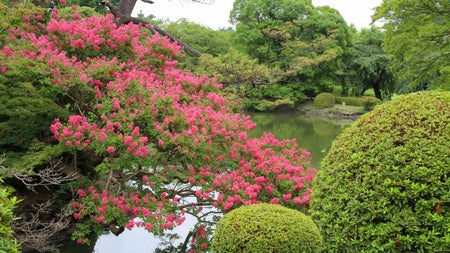
Images Depict Mature Plants
Tuscarora Crape Myrtle Trees for Sale Online
The Tuscarora Crape Myrtle (Lagerstroemia indica x fauriei 'Tuscarora') was developed in 1981 by the National Arboretum in Washington, D.C. through a program focused on creating a Crape Myrtle that was not susceptible to powdery mildew. A huge success, this cultivar is likely the most mildew-resistant Crape Myrtle on the market today. For other enhanced Crape Myrtles, read our blog Today's Crape Myrtles.
This classic southern tree produces soft, coral-pink flower blossoms in late spring that can last until the first frost. Accenting these blooms is rich green foliage that provides some shade below. In the fall, the leaves transform into orange, red, and yellow hues that fit perfectly with the autumn months. Once these leaves fall away, the light cinnamon-colored, smooth bark remains, giving the tree year-round interest.
Ideal for growing zones 7-9, this adaptable tree can tolerate zone 6, but may not grow as tall and may require extra care to protect it from harsh winters.
The Tuscarora Crepe Myrtle is resilient; it is deer resistant, disease and pest resistant, drought-tolerant, and leaf-spot resistant. Despite harsh winters or over-pruning, it is actively growing from early spring through the summer. It is perfect for new gardeners looking to add some color to their gardens.
Only growing to 20 feet tall, the Tuscarora is not the largest Crape Myrtle out there and can be used as a shrub or small tree. Since these deciduous trees don’t grow as tall, they are perfect for yards with limited planting space. They are also perfect as a privacy screen or large hedge when planted together in a line. This conspicuous tree is sure to shine whether you place it in a mixed garden, or as a specimen plant in the center of your yard.

| Hardiness Zone: | 6-9 |
|---|---|
| Mature Height: | 12 to 20 feet |
| Mature Width: | 10 to 14 feet |
| Classification: | Tree form mid-size (10 to 20 feet) |
| Sunlight: | Full sun |
| Habit: | Deciduous, densely branched, multi-stemmed habit |
| Flower Color: | Dark coral-Pink flowers in mid to late summer through the first frost |
| Foliage: | New growth emerges a rich dark green, changing to a equally vibrant orange-red in the fall |
| Soil Condition: | Any well drained soil |
| Water Requirements: | Water well until established |
| Uses: | Extremely attractive when used as a focal point in the mixed border, mass planting, or a specimen planting. Small enough for a large containers on the patio |














